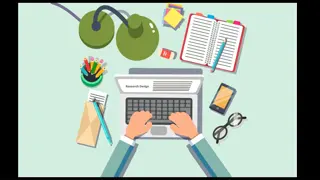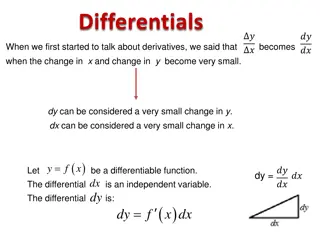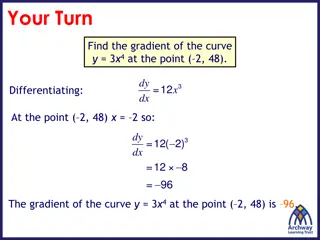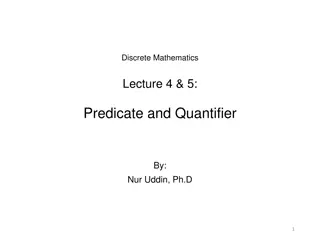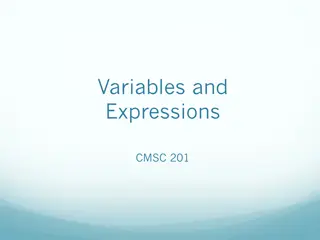Understanding Predicate Calculus: Symbols, Terms, and Variables
Predicate calculus extends propositional calculus by introducing symbols like truth values, constants, variables, and functions. It allows for precise manipulation of components within assertions, enabling the creation of general statements about classes of entities. Learn how predicates define relationships between elements and how variables and functions operate within this logical system.
Download Presentation

Please find below an Image/Link to download the presentation.
The content on the website is provided AS IS for your information and personal use only. It may not be sold, licensed, or shared on other websites without obtaining consent from the author. Download presentation by click this link. If you encounter any issues during the download, it is possible that the publisher has removed the file from their server.
E N D
Presentation Transcript
Predicate logic Predicate logic By By Dr. Ismael AbdulSattar Dr. Ismael AbdulSattar
The Predicate Calculus In propositional calculus, each atomic symbol (P, Q, etc.) denotes a single proposition. There is no way to access the components of an individual assertion. Predicate calculus provides this ability. For example, instead of letting a single propositional symbol, P, denote the entire sentence it rained on Tuesday, we can create a predicate weather that describes a relationship between a date and the weather: weather (Tuesday, rain). Through inference rules we can manipulate predicate calculus expressions, accessing their individual components and inferring new sentences. C93734F252A1F5B0294E69D3A9A7AB8F
Predicate Calculus D E F I N I T I O N SYMBOLS and TERMS Predicate calculus symbols include: 1. Truth symbols true and false (these are reserved symbols). 2. Constant symbols are symbol expressions having the first character lowercase. 3. Variable symbols are symbol expressions beginning with an uppercase character. 4. Function symbols are symbol expressions having the first character lowercase. Functions have an attached arity indicating the number of elements of the domain mapped onto each element of the range. A function expression consists of a function constant of arity n, followed by n terms,t1, t2, ,tn enclosed in parentheses and separated by commas. A predicate calculus termis either a constant, variable, or function expression 3 C93734F252A1F5B0294E69D3A9A7AB8F
Predicate Calculus Predicate calculus also allows expressions to contain variables. Variables let us create general assertions about classes of entities. For example, we could state that for all values of X, where X is a day of the week, the statement weather(X, rain) is true; i.e., it rains every day. Predicate calculus symbol can be any derived from any of the following sets: set of letter, set of digit and the underscore (_). Any predicate calculus should symbol start with a letter. It may represent a variable, a constant, a function or predicate 4 C93734F252A1F5B0294E69D3A9A7AB8F
Predicate Calculus Variables are represented by symbols beginning with an uppercase letter. Thus Ali, ISMAEL, and KAte are legal variables, whereas aLI and ismael are not. Constants name specific objects or properties in the world. Constant symbols must begin with a lowercase letter. Thus george, tree, tall, and blue are examples of well-formed constant symbols. The constants true and false are reserved as truth symbols. 5 C93734F252A1F5B0294E69D3A9A7AB8F
Predicate Calculus functions on objects in the world of discourse. Function symbols (like constants) begin with a lowercase letter. Functions denote a mapping of one or more elements in a domain into unique element in the range Elements of the domain and range are objects in the world of discourse for instance father (ibrahim) abdul for the father of ibrahim yielding the result abdul. 6 C93734F252A1F5B0294E69D3A9A7AB8F
Predicate logic and quantifiers Predicate logic (also called first order predicate logic) has a similar formalism like propositional logic. However, the capability of reasoning and knowledge representation using predicate logic is higher than propositional logic. For instance, it includes two more quantifiers, namely, the essential quantifier ( ) and the existential quantifier ( ). To illustrate the use of the quantifiers, let us consider the following pieces of knowledge. 7 C93734F252A1F5B0294E69D3A9A7AB8F
Predicate logic and quantifiers Knowledge 1 : All boys like sweets. Using predicate logic, we can write the above statement as Knowledge 2 : Some boys like flying kites. Using predicate logic, the above statement can be represented as 8 C93734F252A1F5B0294E69D3A9A7AB8F
Predicate logic and quantifiers You must know the following things For predicates p and q and variables X and Y: 9 C93734F252A1F5B0294E69D3A9A7AB8F
Predicate logic and quantifiers Examples of English sentences represented in predicate 1. If it doesn t rain on Monday, Tom will go to the mountains. weather(rain, monday) go(tom, mountains) 2. Emma is a Doberman pinscher and a good dog. gooddog(emma) isa(emma, doberman) 3. All basketball players are tall. X (basketball_player(X) tall(X)) 4. Some people like anchovies. 5. If wishes were horses, beggars would ride. equal(wishes, horses) ride(beggars) 10 C93734F252A1F5B0294E69D3A9A7AB8F
Predicate logic and quantifiers 6. Nobody likes taxes. 7. Everybody loves somebody The order of the The order of the quantification is very quantification is very important important 8. There is some one who is loved by everyone 11 C93734F252A1F5B0294E69D3A9A7AB8F
Predicate logic and quantifiers 9. Everyone dislikes parsnips The negation effect over quantification The negation effect over quantification is very important is very important 10. Everyone like ice cream 12 C93734F252A1F5B0294E69D3A9A7AB8F
Predicate logic and quantifiers Example : Rewrite the following sentences in FOL. 1. Coconut-crunchy is a biscuit. 2. Mary is a child who takes coconut-crunchy. 3. John loves children who take biscuits. 4. John loves Mary. The above statements can be represented in FOL using two quantifiers X & Y. 1. Biscuit (coconut-crunchy) 2. Child (mary) Takes (mary, coconut-crunchy) 4. Loves (john, mary) 13 C93734F252A1F5B0294E69D3A9A7AB8F
